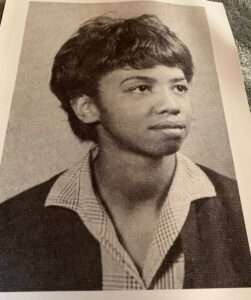
By LIZ WILSON
I was born Feb. 5, 1943, in Salina, Kansas. From 1948-54, I attended the segregated Dunbar School even though I lived across the street from Hawthorne School. I attended summer recreational activities with all the kids on North Eighth, Black and white. We played together all day, had slumber parties and shared meals. It was a confusing time for a young Black child like me. It was hard to comprehend why. I often thought maybe we Black folks were not “human” and this was why we were separated.
I had some great Black teachers at Dunbar, and although we had few resources and only one teacher for two grades, I learned to be the best student I could be. The teachers encouraged me to read almost every book in every room in the school.

I was so influenced by my fourth-grade teacher, Miss Mildred Giles, that I became a teacher like her. She was firm but fair. She cared about me and allowed me to accompany her on a shopping trip to downtown Salina, where she bought me lemon drops and we visited a jewelry store. I will never forget how special that made me feel. I learned to be proud of who I was.
I walked across the street to Hawthorne School in 1954, after Brown v. Topeka Board of Education was settled.

It was a new adventure with my first white teacher, Mrs. Brockman. She was kind and welcoming to me and the other Black student from Dunbar, Wayne Rodgers. He was loved by all for his outgoing personality and his athleticism. I was the Black child who was academically gifted, testing at a 12th grade status in reading comprehension when I was in the 5th grade. That was a big surprise to all, including me.
I learned a great deal about how to live in an integrated community, and that helped me succeed in life.
I never lived in an environment of overt racism, such as with “colored” and “white” signs on restrooms and water fountains. I knew some restaurants did not welcome us, so we did not eat there. I knew we could not purchase or rent houses in some parts of Salina, although we knew former German prisoners of war lived and ate wherever they liked. That was disturbing. I never heard or saw evidence of the KKK or lynching of Black folks but I heard Hays had a lynching. I also never ate at cafes on the highways when we traveled from Salina to Parsons or Leavenworth where relatives lived. We always took a lunch with us and only stopped at restrooms we knew we were welcome, like the Indian Teepee on Highway 40 between Salina and Leavenworth.
We also had wonderful times dancing, playing sports and eating dinners at Carver Center, which had a pool where Bob Caldwell taught me to swim. He was a teacher at Dunbar and later became Salina’s first Black mayor. I was often one of few African Americans in my Wednesday Bible class, which was stressful but taught me early how to deal with this environment. I also learned early there were good and bad folks in every race.
When I was 16, I got a job at the Salina Public Library working in the children’s department with two lovely ladies who taught me a great deal. Twenty years later, I learned my high school librarian, Martha Mae Marsh, had arranged this job for me. I would go on to complete my master’s degree in library science in 1975.

My history teacher, Hilda Smith, encouraged me to write, research and explore my history. My social studies teacher, Dale Brooks, challenged me to read classical literature and change classes to compete with students who would challenge me intellectually. One of these students was Lance Burr, who became attorney general of Kansas. All of these teachers were white, and they cared about me and wanted me to use by intellectual abilities to the fullest.
I went on to become a military wife, living in Germany and Alabama before returning to teach at Hawthorne School in 1975. I worked with exceptional African American teachers at Hawthorne in part because our principal, Eva Velharticky, understood the importance of have a diverse group of teachers teaching a diverse group of students. We stood as role models and taught Black history all year through our curriculum our inclusion in their education. These students were also taught to respect and tolerate differences.
This is what America needs to learn in 2021. Racism and inequality are the root of so many of our problems. I talk with former students on Facebook every day and they say they have many Black friends today because of their Hawthorne experience. That is a tribute to all of us who educated them.
I believe I had a unique educational experience as an African American growing up in Kansas. I wish all those outstanding Black teachers had been hired to continue teaching all kids, but it did not happen. I believe this was a mistake that harmed all kids and is the root of educational problems we see in schools today.
. . .

The Kansas Reflector welcomes opinion pieces from writers who share our goal of widening the conversation about how public policies affect the day-to-day lives of people throughout our state.
Through its opinion section, the Kansas Reflector works to amplify the voices of people who are affected by public policies or excluded from public debate. Find information, including how to submit your own commentary, here.
The above opinion piece is reprinted with permission from Kansas Reflector.





